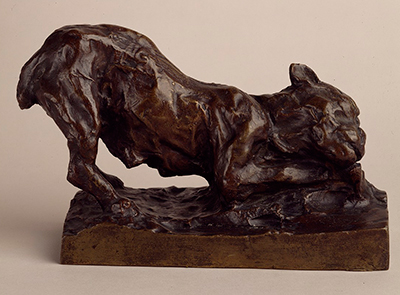 Buy Art Prints Now
Buy Art Prints Nowfrom Amazon
* As an Amazon Associate, and partner with Google Adsense and Ezoic, I earn from qualifying purchases.
The Perra Hambrienta is 1 of 16 cast bronze pieces by Camille Claudel, which was cast in 1893, and the original is currently on display to the general public in the Museo Soumaya in Mexico City.
The cast measures at 15.2cm high, 25.8cm long, and 11.4cm wide, and is coated with patina. Multiple casts were created using the original mould and can be found in multiple museums worldwide, such as the Musée Camille Claudel in Nogent-sur-Seine, France, and the Legion of Honor in San Francisco, USA. Claudel designed the Perra Hambrienta; however, the casting in bronze was entrusted to François Rudier, a prominent French metalworker of the era.
The Perra Hambrienta was commissioned by the Mercure de France, an illustrious French gazette, literary magazine, and publishing house of the 1890s. The Mercure de France was associated with the symbolist movement of the arts, and the Perra Hambrienta was created in a symbolist style, rather than the naturalist or realist style, which influenced many works of art from Claudel and her colleague Auguste Rodin.
Due to the symbolist inception of the Perra Hambrienta, the interpretation of the cast is metaphorical. The original title was Dog Gnawing at a Bone; however, this was changed to the current title which translates to Hungry Female Dog. The Perra Hambrienta provides a novel perception of reality and seeks to portray the hungry dog in a manner which transgresses conventional imagery.
The cast captures the convulsion of the era in which Camille Claudel lived. Europe had been in the midst of the constant battles fought by Europe's colonial powers, and tensions between the world's last empires were steadily rising. The Perra Hambrienta may be interpreted as a metaphorical representation of the European empires vying for dominance, akin to a hungry dog gnawing at a bone. A dog is an appropriate representation of the empires of the era, as dogs are territorial, dominant, and loyal, all of which are characteristics of the empires and the soldiers which fought on their behalf.
The works of Claudel often alluded to her underlying personal grievances, and it is known that her talents were constantly overshadowed by those of her colleagues, principally Rodin. The Perra Hambrienta may, therefore, also be a reflection of her personal frustration and anxiety; that she felt like a dog gnawing at an empty bone, constantly struggling for minuscule rewards. It is evident from the casting that the dog is female and malnourished, which supports the aforementioned interpretation.



